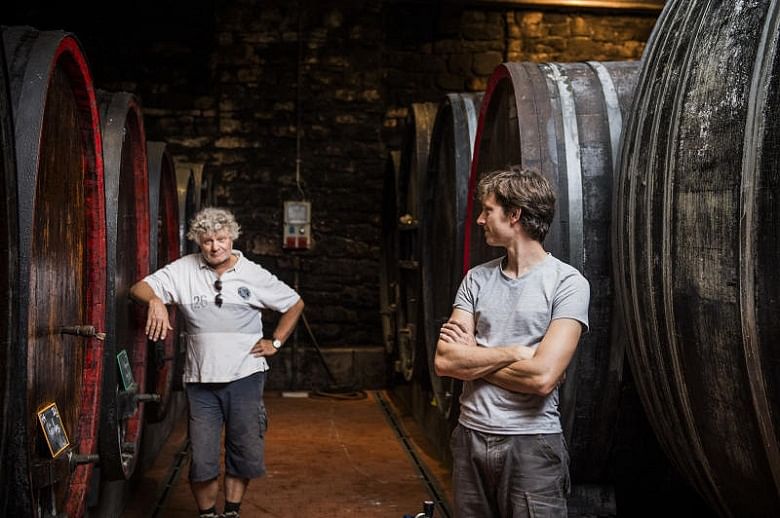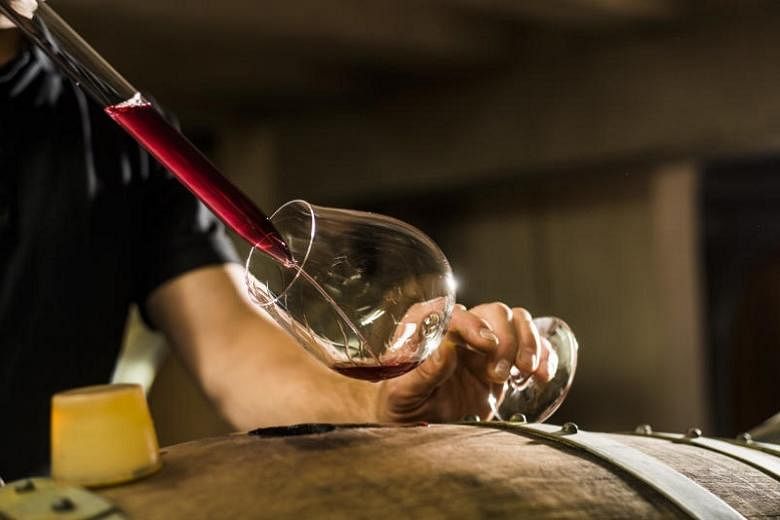EPFIG, FRANCE (NYTIMES) - The Muenchberg vineyard outside this small town is considered one of the best in Alsace. It is among several dozen in the region that have earned the status of grand cru, vineyards from which the wines have the potential to transcend the qualities of the grapes to express the character of the place.
While the notion of grand cru in Alsace reaches back only a few decades, the individuality of Muenchberg has been recognised for centuries.
Cistercian monks first planted vines in a natural amphitheatre in the foothills of the Vosges Mountains in the 12th century. Perhaps for them the potential greatness of Muenchberg was evident in its complexity: diverse exposures angled in all directions and wide-ranging soils including red sandstone with lots of iron and quartz, volcanic sediment and limestone.
From any angle, however, the vineyard is gorgeous. The light is pure and the breeze fresh.
"Grand crus are always beautiful places where you feel the force and energy," said Mr Andre Ostertag, proprietor of Domaine Ostertag, which has holdings in Muenchberg as well as numerous other plots in the middle and northern parts of the Alsace growing region. "In any strong terroir, you have the feeling of the place."
The Alsace wine region, from Mulhouse on the south to Strasbourg on the north, is full of beautiful places and great terroirs. This long, narrow slash of rolling hills and pretty half-timbered towns between the Vosges on the west and the Rhine to the east has its share of great growers and winemakers, both older masters and young up-and-comers.
Alsace also has an image problem. Or, to be more precise, in the United States, it faces the absence of one.
Ask a young person about the wines of Alsace and, chances are, you will be met with a blank stare. The best wine lists in New York may have only a handful of Alsatian bottles and the hipper lists, none at all.
Yet no region in France has a higher percentage of organic or biodynamic growers than Alsace, which theoretically should attract the keepers of natural wine lists. It is time for a deeper look at Alsace, where I spent a few days this year visiting a range of producers. I tasted many wonderful wines, like Ostertag's 2015 riesling from the Muenchberg vineyard - savoury and saline, full of power and finesse.
And, for a wine of less grandeur, his 2015 sylvaner, a grape practically unknown in the US, is floral and zesty.
Alsace did not always draw a blank in America. In the 1980s, when I was first learning about wine, the slender bottles from Alsace were known as delicious high-quality values, dry contrasts to the generally sweet wines from Germany made from a similar set of grapes.
It helped that Andre Soltner, the superstar chef and owner of Lutece, New York's leading restaurant back then, was Alsatian. His list was full
of the top names of Bordeaux and Burgundy, but the wines of Alsace were his favoured selections with the cuisine.
In the 1990s, estates such as Zind Humbrecht became critical darlings. But the wines also seemed to ebb from the general consciousness and slowly slip away.
The problem was that over time, too many of the historically dry wines of Alsace were sold with residual sugar in them. These wines were sweet, heavy and out of balance, with no indication of sweetness on the label.
The problem is not new and much has been done to rectify it. But the perception appears to linger.
Mr Ostertag attributed the increasing sweetness to US critics who favourably rewarded those wines. "The sweeter the wine, the higher the score," he said. "More and more wine appeared with sweetness and nothing more."
Winemakers in Alsace have been working on solutions to the sweetness issue for years now.

Partly, the problem was the result of idealism. Producers such as Zind Humbrecht and Domaine Marcel Deiss, who work organically and biodynamically, were loath to pick grapes before they achieved absolute ripeness. They refused to add powerful store-bought yeast to complete fermentations that the indigenous yeast had not finished, which left residual sugar in the wine.
Over time, Mr Olivier Humbrecht, whose family owns Zind Humbrecht, adjusted his viticulture so that ripeness could be achieved with less sugar in the grapes.
You can taste the difference. Bottles that I used to find almost syrupy are now sharp and focused, even when they do have some residual sugar. For years, Zind Humbrecht has put a code on its label to show the level of sweetness consumers can expect. The numbers, or indices, run from 1 (dry) to 5 (rich and sweet).
I tasted a 2015 riesling from the Clos Hauserer vineyard, marked Indice 3, that was clearly sweet, yet it was vibrant and refreshing, with a balancing zing of acidity that I would not have found a decade ago.
Zind Humbrecht's dry 2015s are lovely, including a fragrant gentle muscat from the grand cru Goldert vineyard and a deeply mineral, concentrated riesling from the grand cru Brand vineyard. I was especially impressed with its pinot gris, a grape that seems particularly susceptible in Alsace to cloying heaviness.
"There's a lot of work done in the vineyard getting the precision right in pinot gris," said Ms Jolene Hunter, Zind Humbrecht's export manager. "If you hesitate for a day, the acidity drops massively and alcohol shoots up."
The 2014 pinot gris from the Rotenberg vineyard was beautifully balanced, fruity and saline, deliciously refreshing.

At Domaine Marcel Deiss, Mr Jean-Michel Deiss and his son, Mathieu, have also been working in the vineyard to achieve riper grapes with less sugar. Mr Mathieu Deiss' side project, Vignoble du Reveur, allows him to experiment with techniques popularised in natural wines: macerating white wines with their skins in the manner used for making red wines, fermenting and ageing in amphoras, and working without sulphur dioxide, the stabiliser used in most wines.
The 2015 Vignoble du Reveur Singulier Sec is, like many of the Deiss wines, a blend of different grapes, in this case riesling, pinot gris, pinot blanc and pinot noir. It is a beautiful amber, textured and tannic, bone-dry, fresh and energetic. It reminded me of the wines of Radikon, the great producer from Friuli-Venezia Giulia.
Residual sugar does have an important place in Alsace, as long as the wines are balanced and consumers know what to expect.
But Mr Deiss leaves this responsibility to the wine trade and to consumers themselves rather than indicating on the bottles the characteristics of its various bottles.

At Domaine Valentin Zusslin, where Ms Marie Zusslin and her brother, Jean-Paul, have managed the estate since 2008, there is no question about which wines are dry and which is not.
"In Alsace, heavier, sweeter wines were understood," she said, noting that that is not the case internationally. To eliminate confusion, the Zusslin wines are dry unless clearly indicated.
From the Clos Liebenberg, a south-east-facing vineyard outside Orschwihr in the southern part of the region, you can see the Swiss Alps on a clear day. Riesling is planted in rows and on terraces. Beehives are nearby for honey and pear trees for making eau de vie. Like all of the Zusslin estate, it has been farmed biodynamically for almost 20 years. Each element of the undulating terrain is different, with varying microclimates, exposures and soils.
"To observe is paramount," said Ms Zusslin, a key tenet of biodynamic viticulture.
The Zusslin wines reflect this precision. They are characterised by acidity, energy and a savoury quality that I can only describe as saltiness.
I especially liked the lively 2014 sylvaner and the gentle 2014 riesling, both from the Bollenberg vineyard, along with the mineral 2013 riesling from the grand cru Pfingstberg vineyard and the linear 2013 riesling from Clos Liebenberg.
Alone among the estates that I visited, the venerable Maison Trimbach did not acknowledge any confusion in the marketplace about its wines.
The US is its biggest market, said Mr Pierre Trimbach, who oversees the winemaking, and Trimbach continues to do well there. "We've had no problems," he said.
Perhaps that is because Trimbach has never deviated from its policy of clarity in its labelling. Consumers know that its wines, such as the great riesling Clos St Hune and the more affordable Cuvee Frederic Emile, are going to be dry.
But when I said this to Mr Trimbach, he grimaced. "Don't say dry wine," he said. "It's No. 1, balanced; No. 2, balanced; and No. 3, balanced."
Balanced - I can live with that.




